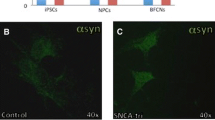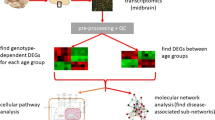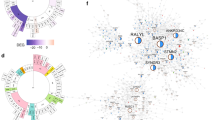Abstract
α-Synuclein has been implicated in the pathogenesis of Parkinson’s disease. The function of α-synuclein has not been deciphered yet; however, it might play a role in vesicle function, transport, or as a chaperone. α-Synuclein belongs to a family of three proteins, which includes β- and γ-synuclein. γ-Synuclein shares 60% similarity with α-synuclein. Similar to α-synuclein, a physiological function for γ-synuclein has not been defined yet, but it has been implicated in tumorgenesis and neurodegeneration. Interestingly, neither α- (SNCA−/−), γ- (SNCG−/−), nor α/γ- (SNCA_G−/−) deficient mice are present with any obvious phenotype. Using microarray analysis, we thus investigated whether deficiency of α- and γ-synuclein leads to similar compensatory mechanisms at the RNA level and whether similar transcriptional signatures are altered in the brain. Sixty-five genes were differentially expressed in all mice. SNCA−/− mice and SNCG−/− mice shared 84 differentially expressed genes, SNCA−/− and SNCA_G−/− expressed 79 genes, and SNCG−/− and SNCA_G−/− expressed 148 genes. For many of the physiological pathways such as dopamine receptor signaling (down-regulated), cellular development, nervous system function, and cell death (up-regulated), we found groups of genes that were similarly altered in SNCA−/− and SNCG−/− mice. In one of the pathways altered in both models, we found Mapk1 as the core transcript. Other gene groups, however, such as TGF-β signaling and apoptosis pathways genes were significantly up-regulated in the SNCA−/− mice but down-regulated in SNCG−/− mice. β-synuclein expression was not significantly altered in any of the models.




Similar content being viewed by others
References
Spillantini MG, Schmidt ML, Lee VM, Trojanowski JQ, Jakes R, Goedert M (1997) Alpha-synuclein in Lewy bodies. Nature 388:839–840
Spillantini MG, Crowther RA, Jakes R, Hasegawa M, Goedert M (1998) Alpha-synuclein in filamentous inclusions of Lewy bodies from Parkinson’s disease and dementia with Lewy bodies. Proc Natl Acad Sci USA 95:6469–6473
Polymeropoulos MH, Lavedan C, Leroy E, Ide SE, Dehejia A, Dutra A, Pike B, Root H, Rubenstein J, Boyer R, Stenroos ES, Chandrasekharappa S, Athanassiadou A, Papapetropoulos T, Johnson WG, Lazzarini AM, Duvoisin RC, Di Iorio G, Golbe LI, Nussbaum RL (1997) Mutation in the alpha-synuclein gene identified in families with Parkinson’s disease. Science 276:2045–2047
Kruger R, Kuhn W, Muller T, Woitalla D, Graeber M, Kosel S, Przuntek H, Epplen JT, Schols L, Riess O (1998) Ala30Pro mutation in the gene encoding alpha-synuclein in Parkinson’s disease. Nat Genet 18:106–108
Singleton AB, Farrer M, Johnson J, Singleton A, Hague S, Kachergus J, Hulihan M, Peuralinna T, Dutra A, Nussbaum R, Lincoln S, Crawley A, Hanson M, Maraganore D, Adler C, Cookson MR, Muenter M, Baptista M, Miller D, Blancato J, Hardy J, Gwinn-Hardy K (2003) Alpha-synuclein locus triplication causes Parkinson’s disease. Science 302:841
Chartier-Harlin MC, Kachergus J, Roumier C, Mouroux V, Douay X, Lincoln S, Levecque C, Larvor L, Andrieux J, Hulihan M, Waucquier N, Defebvre L, Amouyel P, Farrer M, Destee A (2004) Alpha-synuclein locus duplication as a cause of familial Parkinson’s disease. Lancet 364:1167–1169
Zarranz JJ, Alegre J, Gomez-Esteban JC, Lezcano E, Ros R, Ampuero I, Vidal L, Hoenicka J, Rodriguez O, Atares B, Llorens V, Gomez Tortosa E, del Ser T, Munoz DG, de Yebenes JG (2004) The new mutation, E46K, of alpha-synuclein causes Parkinson and Lewy body dementia. Ann Neurol 55:164–173
Masliah E, Rockenstein E, Veinbergs I, Mallory M, Hashimoto M, Takeda A, Sagara Y, Sisk A, Mucke L (2000) Dopaminergic loss and inclusion body formation in alpha-synuclein mice: implications for neurodegenerative disorders. Science 287:1265–1269
Feany MB, Bender WW (2000) A Drosophila model of Parkinson’s disease. Nature 404:394–398
Murphy DD, Rueter SM, Trojanowski JQ, Lee VM (2000) Synucleins are developmentally expressed, and alpha-synuclein regulates the size of the presynaptic vesicular pool in primary hippocampal neurons. J Neurosci 20:3214–3220
Uversky VN, Li J, Souillac P, Millett IS, Doniach S, Jakes R, Goedert M, Fink AL (2002) Biophysical properties of the synucleins and their propensities to fibrillate: inhibition of alpha-synuclein assembly by beta- and gamma-synucleins. J Biol Chem 277:11970–11978
Goedert M (2001) Alpha-synuclein and neurodegenerative diseases. Nat Rev Neurosci 2:492–501
Lavedan C (1998) The synuclein family. Genome Res 8:871–880
Buchman VL, Adu J, Pinon LG, Ninkina NN, Davies AM (1998) Persyn, a member of the synuclein family, influences neurofilament network integrity. Nat Neurosci 1:101–103
Hashimoto M, Yoshimoto M, Sisk A, Hsu LJ, Sundsmo M, Kittel A, Saitoh T, Miller A, Masliah E (1997) NACP, a synaptic protein involved in Alzheimer’s disease, is differentially regulated during megakaryocyte differentiation. Biochem Biophys Res Commun 237:611–616
Ninkina NN, Privalova EM, Pinon LG, Davies AM, Buchman VL (1999) Developmentally regulated expression of persyn, a member of the synuclein family, in skin. Exp Cell Res 246:308–311
Ji H, Liu YE, Jia T, Wang M, Liu J, Xiao G, Joseph BK, Rosen C, Shi YE (1997) Identification of a breast cancer-specific gene, BCSG1, by direct differential cDNA sequencing. Cancer Res 57:759–764
Ninkina NN, Alimova-Kost MV, Paterson JW, Delaney L, Cohen BB, Imreh S, Gnuchev NV, Davies AM, Buchman VL (1998) Organization, expression and polymorphism of the human persyn gene. Hum Mol Genet 7:1417–1424
Bruening W, Giasson BI, Klein-Szanto AJ, Lee VM, Trojanowski JQ, Godwin AK (2000) Synucleins are expressed in the majority of breast and ovarian carcinomas and in preneoplastic lesions of the ovary. Cancer 88:2154–2163
Jiang Y, Liu YE, Goldberg ID, Shi YE (2004) Gamma synuclein, a novel heat-shock protein-associated chaperone, stimulates ligand-dependent estrogen receptor alpha signaling and mammary tumorigenesis. Cancer Res 64:4539–4546
Surgucheva IG, Sivak JM, Fini ME, Palazzo RE, Surguchov AP (2003) Effect of gamma-synuclein overexpression on matrix metalloproteinases in retinoblastoma Y79 cells. Arch Biochem Biophys 410:167–176
Specht CG, Tigaret CM, Rast GF, Thalhammer A, Rudhard Y, Schoepfer R (2005) Subcellular localisation of recombinant alpha- and gamma-synuclein. Mol Cell Neurosci 28:326–334
Abeliovich A, Schmitz Y, Farinas I, Choi-Lundberg D, Ho WH, Castillo PE, Shinsky N, Verdugo JM, Armanini M, Ryan A, Hynes M, Phillips H, Sulzer D, Rosenthal A (2000) Mice lacking alpha-synuclein display functional deficits in the nigrostriatal dopamine system. Neuron 25:239–252
Ninkina N, Papachroni K, Robertson DC, Schmidt O, Delaney L, O’Neill F, Court F, Rosenthal A, Fleetwood-Walker SM, Davies AM, Buchman VL (2003) Neurons expressing the highest levels of gamma-synuclein are unaffected by targeted inactivation of the gene. Mol Cell Biol 23:8233–8245
Robertson DC, Schmidt O, Ninkina N, Jones PA, Sharkey J, Buchman VL (2004) Developmental loss and resistance to MPTP toxicity of dopaminergic neurones in substantia nigra pars compacta of gamma-synuclein, alpha-synuclein and double alpha/gamma-synuclein null mutant mice. J Neurochem 89:1126–1136
Dauer W, Kholodilov N, Vila M, Trillat AC, Goodchild R, Larsen KE, Staal R, Tieu K, Schmitz Y, Yuan CA, Rocha M, Jackson-Lewis V, Hersch S, Sulzer D, Przedborski S, Burke R, Hen R (2002) Resistance of alpha-synuclein null mice to the parkinsonian neurotoxin MPTP. Proc Natl Acad Sci USA 99:14524–14529
Schluter OM, Fornai F, Alessandri MG, Takamori S, Geppert M, Jahn R, Sudhof TC (2003) Role of alpha-synuclein in 1-methyl-4-phenyl-1,2,3,6-tetrahydropyridine-induced Parkinsonism in mice. Neuroscience 118:985–1002
Papachroni K, Ninkina N, Wanless J, Kalofoutis AT, Gnuchev NV, Buchman VL (2005) Peripheral sensory neurons survive in the absence of alpha- and gamma-synucleins. J Mol Neurosci 25:157–164
Hochberg Y, Benjamini Y (1990) More powerful procedures for multiple significance testing. Stat Med 9:811–818
Pfaffl MW (2001) A new mathematical model for relative quantification in real-time RT-PCR. Nucleic Acids Res 29:e45
Wentz-Hunter K, Ueda J, Yue BY (2002) Protein interactions with myocilin. Invest Ophthalmol Vis Sci 43:176–182
Robinson IM, Ranjan R, Schwarz TL (2002) Synaptotagmins I and IV promote transmitter release independently of Ca(2+) binding in the C(2)A domain. Nature 418:336–340
Lim DS, Kirsch DG, Canman CE, Ahn JH, Ziv Y, Newman LS, Darnell RB, Shiloh Y, Kastan MB (1998) ATM binds to beta-adaptin in cytoplasmic vesicles. Proc Natl Acad Sci USA 95:10146–10151
Berg D, Holzmann C, Riess O (2003) 14-3-3 proteins in the nervous system. Nat Rev Neurosci 4:752–762
Berg D, Riess O, Bornemann A (2003) Specification of 14-3-3 proteins in Lewy bodies. Ann Neurol 54:135
Ostrerova N, Petrucelli L, Farrer M, Mehta N, Choi P, Hardy J, Wolozin B (1999) Alpha-synuclein shares physical and functional homology with 14-3-3 proteins. J Neurosci 19:5782–5791
Sato S, Chiba T, Sakata E, Kato K, Mizuno Y, Hattori N, Tanaka K (2006) 14-3-3eta is a novel regulator of parkin ubiquitin ligase. EMBO J 25:211–221
Chandra S, Fornai F, Kwon HB, Yazdani U, Atasoy D, Liu X, Hammer RE, Battaglia G, German DC, Castillo PE, Sudhof TC (2004) Double-knockout mice for alpha- and beta-synucleins: effect on synaptic functions. Proc Natl Acad Sci USA 101:14966–14971
Wersinger C, Sidhu A (2005) Disruption of the interaction of alpha-synuclein with microtubules enhances cell surface recruitment of the dopamine transporter. Biochemistry 44:13612–13624
Adamczyk A, Kazmierczak A, Strosznajder JB (2006) Alpha-synuclein and its neurotoxic fragment inhibit dopamine uptake into rat striatal synaptosomes relationship to nitric oxide. Neurochem Int 49(4):407–412
Perez RG, Waymire JC, Lin E, Liu JJ, Guo F, Zigmond MJ (2002) A role for alpha-synuclein in the regulation of dopamine biosynthesis. J Neurosci 22:3090–3099
Xu J, Kao SY, Lee FJ, Song W, Jin LW, Yankner BA (2002) Dopamine-dependent neurotoxicity of alpha-synuclein: a mechanism for selective neurodegeneration in Parkinson disease. Nat Med 8:600–606
Surgucheva I, Ninkina N, Buchman VL, Grasing K, Surguchov A (2005) Protein aggregation in retinal cells and approaches to cell protection. Cell Mol Neurobiol 25:1051–1066
Toska K, Kleppe R, Armstrong CG, Morrice NA, Cohen P, Haavik J (2002) Regulation of tyrosine hydroxylase by stress-activated protein kinases. J Neurochem 83:775–783
Haycock JW, Ahn NG, Cobb MH, Krebs EG (1992) ERK1 and ERK2, two microtubule-associated protein 2 kinases, mediate the phosphorylation of tyrosine hydroxylase at serine-31 in situ. Proc Natl Acad Sci USA 89:2365–2369
Ferrer I, Blanco R, Carmona M, Puig B, Barrachina M, Gomez C, Ambrosio S (2001) Active, phosphorylation-dependent mitogen-activated protein kinase (MAPK/ERK), stress-activated protein kinase/c-Jun N-terminal kinase (SAPK/JNK), and p38 kinase expression in Parkinson’s disease and Dementia with Lewy bodies. J Neural Transm 108:1383–1396
Iwata A, Maruyama M, Kanazawa I, Nukina N (2001) Alpha-synuclein affects the MAPK pathway and accelerates cell death. J Biol Chem 276:45320–45329
Surguchov A, Palazzo RE, Surgucheva I (2001) Gamma synuclein: subcellular localization in neuronal and non-neuronal cells and effect on signal transduction. Cell Motil Cytoskelet 49:218–228
Iwata A, Miura S, Kanazawa I, Sawada M, Nukina N (2001) Alpha-synuclein forms a complex with transcription factor Elk-1. J Neurochem 77:239–252
Gutkind JS (1998) The pathways connecting G protein-coupled receptors to the nucleus through divergent mitogen-activated protein kinase cascades. J Biol Chem 273:1839–1842
Pronin AN, Morris AJ, Surguchov A, Benovic JL (2000) Synucleins are a novel class of substrates for G protein-coupled receptor kinases. J Biol Chem 275:26515–26522
Arawaka S, Wada M, Goto S, Karube H, Sakamoto M, Ren CH, Koyama S, Nagasawa H, Kimura H, Kawanami T, Kurita K, Tajima K, Daimon M, Baba M, Kido T, Saino S, Goto K, Asao H, Kitanaka C, Takashita E, Hongo S, Nakamura T, Kayama T, Suzuki Y, Kobayashi K, Katagiri T, Kurokawa K, Kurimura M, Toyoshima I, Niizato K, Tsuchiya K, Iwatsubo T, Muramatsu M, Matsumine H, Kato T (2006) The role of G-protein-coupled receptor kinase 5 in pathogenesis of sporadic Parkinson’s disease. J Neurosci 26:9227–9238
Surgucheva I, Park BC, Yue BY, Tomarev S, Surguchov A (2005) Interaction of myocilin with gamma-synuclein affects its secretion and aggregation. Cell Mol Neurobiol 25:1009–1033
Hashimoto M, Rockenstein E, Mante M, Mallory M, Masliah E (2001) Beta-synuclein inhibits alpha-synuclein aggregation: a possible role as an anti-Parkinsonian factor. Neuron 32:213–223
Snyder H, Mensah K, Hsu C, Hashimoto M, Surgucheva IG, Festoff B, Surguchov A, Masliah E, Matouschek A, Wolozin B (2005) Beta-synuclein reduces proteasomal inhibition by alpha-synuclein but not gamma-synuclein. J Biol Chem 280:7562–7569
Mead AN, Stephens DN (2003) Selective disruption of stimulus–reward learning in glutamate receptor gria1 knock-out mice. J Neurosci 23:1041–1048
Mead AN, Morris HV, Dixon CI, Rulten SL, Mayne LV, Zamanillo D, Stephens DN (2006) AMPA receptor GluR2, but not GluR1, subunit deletion impairs emotional response conditioning in mice. Behav Neurosci 120:241–248
Schmitt WB, Sprengel R, Mack V, Draft RW, Seeburg PH, Deacon RM, Rawlins JN, Bannerman DM (2005) Restoration of spatial working memory by genetic rescue of GluR-A-deficient mice. Nat Neurosci 8:270–272
Ferguson GD, Anagnostaras SG, Silva AJ, Herschman HR (2000) Deficits in memory and motor performance in synaptotagmin IV mutant mice. Proc Natl Acad Sci USA 97:5598–5603
Eilam R, Peter Y, Elson A, Rotman G, Shiloh Y, Groner Y, Segal M (1998) Selective loss of dopaminergic nigro-striatal neurons in brains of Atm-deficient mice. Proc Natl Acad Sci USA 95:12653–12656
Eilam R, Peter Y, Groner Y, Segal M (2003) Late degeneration of nigro-striatal neurons in ATM−/− mice. Neuroscience 121:83–98
Brose N, Petrenko AG, Sudhof TC, Jahn R (1992) Synaptotagmin: a calcium sensor on the synaptic vesicle surface. Science 256:1021–1025
Mandel S, Grunblatt E, Youdim M (2000) cDNA microarray to study gene expression of dopaminergic neurodegeneration and neuroprotection in MPTP and 6-hydroxydopamine models: implications for idiopathic Parkinson’s disease. J Neural Transm Suppl 60:117–124
Grunblatt E, Mandel S, Maor G, Youdim MB (2001) Gene expression analysis in N-methyl-4-phenyl-1,2,3,6-tetrahydropyridine mice model of Parkinson’s disease using cDNA microarray: effect of R-apomorphine. J Neurochem 78:1–12
Holtz WA, O’Malley KL (2003) Parkinsonian mimetics induce aspects of unfolded protein response in death of dopaminergic neurons. J Biol Chem 278:19367–19377
Chun HS, Gibson GE, DeGiorgio LA, Zhang H, Kidd VJ, Son JH (2001) Dopaminergic cell death induced by MPP(+), oxidant and specific neurotoxicants shares the common molecular mechanism. J Neurochem 76:1010–1021
Yoo MS, Chun HS, Son JJ, DeGiorgio LA, Kim DJ, Peng C, Son JH (2003) Oxidative stress regulated genes in nigral dopaminergic neuronal cells: correlation with the known pathology in Parkinson’s disease. Brain Res Mol Brain Res 110:76–84
Acknowledgments
We would like to thank Dr. Nguyen for helpful comments on the manuscript. This work was supported by the IZKF (01KS 9602/4)/BMBF project to OR and by Welcome Trust Grants to VB.
Author information
Authors and Affiliations
Corresponding author
Electronic supplementary material
Below is the link to the electronic supplementary material.
Supplementary Table S1
Full names of the differentially regulated genes in SNCA−/−, SNCG−/− and SNCA_G−/− mice belonging to figure 3 (DOC 92 kb)
Rights and permissions
About this article
Cite this article
Kuhn, M., Haebig, K., Bonin, M. et al. Whole genome expression analyses of single- and double-knock-out mice implicate partially overlapping functions of alpha- and gamma-synuclein. Neurogenetics 8, 71–81 (2007). https://doi.org/10.1007/s10048-007-0079-z
Received:
Accepted:
Published:
Issue Date:
DOI: https://doi.org/10.1007/s10048-007-0079-z




